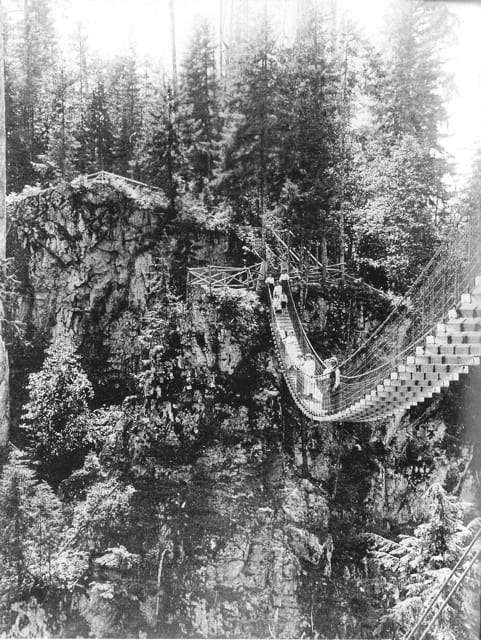Lynn Canyon Suspension Bridge celebrates 100 years
May 15, 2012
BY TRICIA EDGAR: In 2012, Lynn Canyon Park is 100 years old. Let’s go on a walk through the trails of the canyon a century ago. If you’d visited then, what would you have seen?It’s a sunny day, and you decide to take the small rail car up from the waterfront to get to the park. As you move up the hill toward Lynn Valley, you see small houses that dot the landscape, standing amidst the remains of a giant forest. The tram moves up the road the place where Dempsey and Lynn Valley Road meet today. You get off the tram and follow the trail into the park. As you walk, you can hear the music of a live band playing in the bandstand and the shouts of laughter from the children playing in the playground.Huge stumps of Douglas-fir and Western Red Cedar dot the landscape, and small alder trees grow abundantly, surrounded by salmonberries and other sun-loving shrubs. You buy lemonade for eight cents from the refreshment stand and sit down to enjoy a relaxing lunch in the picnic area under the shade of a few smaller trees. You hear the water rushing through the canyon and feel the breeze as it blows through alders that line the creek. You reach into your pocket, looking for 10 cents that will allow you to cross the suspension bridge, a swinging bridge that stands a daunting fifty meters above the rushing Lynn Creek.This was Lynn Canyon Park when it opened on September 12, 1912. When Mr. J.P. Crawford originally proposed a park to the McTavish brothers who had logged the area, all parties involved had great real estate dreams of drawing people to Lynn Valley. Although logging was the main industry in the area, Lynn Valley was still fairly heavily treed and would be a beautiful, sought-after area in which to live. To create the core of the park, the McTavish brothers made a 12-acre donation which was met with a 10-acre donation from the District Council of North Vancouver.Their business venture was a huge success, and for seven years the park was a thriving tourist destination. However, just seven short years after the park opened, it changed dramatically. Following three weeks of straight rain, on November 14, 1919, several acres of land collapsed into the river, bringing with it most of the park infrastructure: the caretaker’s cottage, the bandstand, the refreshment booth, and the picnic tables.Over time, the park has been rebuilt and transformed again and again by nature and by people. Since 1971, the Lynn Canyon Ecology Centre has provided education for over 2.6 million visitors to the park. The Centre was built in the shape of the Dogwood blossom, B.C’s floral emblem. The Centre provides park visitors with an opportunity to learn even more about this ever-changing wilderness that sits just next door to Vancouver.Over the last 100 years, the once-tiny firs, cedars, and hemlocks left behind by long ago loggers have grown into huge trees that inspire millions of visitors from around the world. The suspension bridge draws line-ups of visitors every summer, and it’s cheaper than it used to be: it’s free! Today, Lynn Canyon Park conserves 617 acres of temperate rainforest, providing a wilderness oasis on the urban fringe and catering to families, tourists and outdoor enthusiasts alike.- Tricia Edgar is the Lynn Canyon Ecology Centre's eduction programmer.
You buy lemonade for eight cents from the refreshment stand and sit down to enjoy a relaxing lunch in the picnic area under the shade of a few smaller trees. You hear the water rushing through the canyon and feel the breeze as it blows through alders that line the creek. You reach into your pocket, looking for 10 cents that will allow you to cross the suspension bridge, a swinging bridge that stands a daunting fifty meters above the rushing Lynn Creek.This was Lynn Canyon Park when it opened on September 12, 1912. When Mr. J.P. Crawford originally proposed a park to the McTavish brothers who had logged the area, all parties involved had great real estate dreams of drawing people to Lynn Valley. Although logging was the main industry in the area, Lynn Valley was still fairly heavily treed and would be a beautiful, sought-after area in which to live. To create the core of the park, the McTavish brothers made a 12-acre donation which was met with a 10-acre donation from the District Council of North Vancouver.Their business venture was a huge success, and for seven years the park was a thriving tourist destination. However, just seven short years after the park opened, it changed dramatically. Following three weeks of straight rain, on November 14, 1919, several acres of land collapsed into the river, bringing with it most of the park infrastructure: the caretaker’s cottage, the bandstand, the refreshment booth, and the picnic tables.Over time, the park has been rebuilt and transformed again and again by nature and by people. Since 1971, the Lynn Canyon Ecology Centre has provided education for over 2.6 million visitors to the park. The Centre was built in the shape of the Dogwood blossom, B.C’s floral emblem. The Centre provides park visitors with an opportunity to learn even more about this ever-changing wilderness that sits just next door to Vancouver.Over the last 100 years, the once-tiny firs, cedars, and hemlocks left behind by long ago loggers have grown into huge trees that inspire millions of visitors from around the world. The suspension bridge draws line-ups of visitors every summer, and it’s cheaper than it used to be: it’s free! Today, Lynn Canyon Park conserves 617 acres of temperate rainforest, providing a wilderness oasis on the urban fringe and catering to families, tourists and outdoor enthusiasts alike.- Tricia Edgar is the Lynn Canyon Ecology Centre's eduction programmer.
 You buy lemonade for eight cents from the refreshment stand and sit down to enjoy a relaxing lunch in the picnic area under the shade of a few smaller trees. You hear the water rushing through the canyon and feel the breeze as it blows through alders that line the creek. You reach into your pocket, looking for 10 cents that will allow you to cross the suspension bridge, a swinging bridge that stands a daunting fifty meters above the rushing Lynn Creek.This was Lynn Canyon Park when it opened on September 12, 1912. When Mr. J.P. Crawford originally proposed a park to the McTavish brothers who had logged the area, all parties involved had great real estate dreams of drawing people to Lynn Valley. Although logging was the main industry in the area, Lynn Valley was still fairly heavily treed and would be a beautiful, sought-after area in which to live. To create the core of the park, the McTavish brothers made a 12-acre donation which was met with a 10-acre donation from the District Council of North Vancouver.Their business venture was a huge success, and for seven years the park was a thriving tourist destination. However, just seven short years after the park opened, it changed dramatically. Following three weeks of straight rain, on November 14, 1919, several acres of land collapsed into the river, bringing with it most of the park infrastructure: the caretaker’s cottage, the bandstand, the refreshment booth, and the picnic tables.Over time, the park has been rebuilt and transformed again and again by nature and by people. Since 1971, the Lynn Canyon Ecology Centre has provided education for over 2.6 million visitors to the park. The Centre was built in the shape of the Dogwood blossom, B.C’s floral emblem. The Centre provides park visitors with an opportunity to learn even more about this ever-changing wilderness that sits just next door to Vancouver.Over the last 100 years, the once-tiny firs, cedars, and hemlocks left behind by long ago loggers have grown into huge trees that inspire millions of visitors from around the world. The suspension bridge draws line-ups of visitors every summer, and it’s cheaper than it used to be: it’s free! Today, Lynn Canyon Park conserves 617 acres of temperate rainforest, providing a wilderness oasis on the urban fringe and catering to families, tourists and outdoor enthusiasts alike.- Tricia Edgar is the Lynn Canyon Ecology Centre's eduction programmer.
You buy lemonade for eight cents from the refreshment stand and sit down to enjoy a relaxing lunch in the picnic area under the shade of a few smaller trees. You hear the water rushing through the canyon and feel the breeze as it blows through alders that line the creek. You reach into your pocket, looking for 10 cents that will allow you to cross the suspension bridge, a swinging bridge that stands a daunting fifty meters above the rushing Lynn Creek.This was Lynn Canyon Park when it opened on September 12, 1912. When Mr. J.P. Crawford originally proposed a park to the McTavish brothers who had logged the area, all parties involved had great real estate dreams of drawing people to Lynn Valley. Although logging was the main industry in the area, Lynn Valley was still fairly heavily treed and would be a beautiful, sought-after area in which to live. To create the core of the park, the McTavish brothers made a 12-acre donation which was met with a 10-acre donation from the District Council of North Vancouver.Their business venture was a huge success, and for seven years the park was a thriving tourist destination. However, just seven short years after the park opened, it changed dramatically. Following three weeks of straight rain, on November 14, 1919, several acres of land collapsed into the river, bringing with it most of the park infrastructure: the caretaker’s cottage, the bandstand, the refreshment booth, and the picnic tables.Over time, the park has been rebuilt and transformed again and again by nature and by people. Since 1971, the Lynn Canyon Ecology Centre has provided education for over 2.6 million visitors to the park. The Centre was built in the shape of the Dogwood blossom, B.C’s floral emblem. The Centre provides park visitors with an opportunity to learn even more about this ever-changing wilderness that sits just next door to Vancouver.Over the last 100 years, the once-tiny firs, cedars, and hemlocks left behind by long ago loggers have grown into huge trees that inspire millions of visitors from around the world. The suspension bridge draws line-ups of visitors every summer, and it’s cheaper than it used to be: it’s free! Today, Lynn Canyon Park conserves 617 acres of temperate rainforest, providing a wilderness oasis on the urban fringe and catering to families, tourists and outdoor enthusiasts alike.- Tricia Edgar is the Lynn Canyon Ecology Centre's eduction programmer.
Looking for more?
Related News
Community Calendar
-
Dec 126:30 PM - 8:30 PMRoyal Canadian Legion Branch 114, 1630 Lynn Valley Rd, North Vancouver, BC V7J 2B4, Canada
-
Dec 12
Canapes & Cocktails
7:00 PM - 9:00 PMThe Mollie Nye House 940 Lynn Valley Rd, North Vancouver BC V7J 1Z7, Canada -
Dec 13
Holiday Ukulele Sing-along
12:00 PM - 12:30 PMLynn Valley Library 1277 Lynn Valley Rd, North Vancouver BC V7J 0A2, Canada -
Dec 13
What's A.I.?
1:00 PM - 2:00 PMLynn Valley Library 1277 Lynn Valley Rd, North Vancouver BC V7J 0A2, Canada






